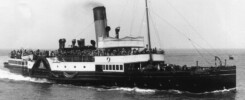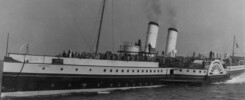Despite the weather in 1955 being described in the accounts of Cosens & Co as ‘the best experienced for several years’ the financial results for the season were not great with this being attributed ‘mainly to heavily increased operating costs’.
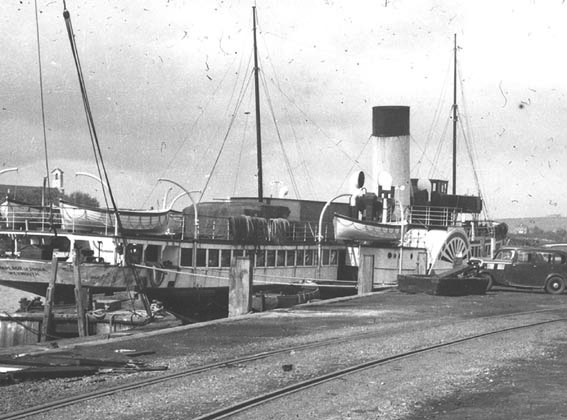
For 1956 steamer services remained as before with Emperor of India (pictured above), Embassy and Monarch based at Bournemouth and Consul at Weymouth but the weather was less good and the company made a net loss of £4,092 17s 3d which is about £94K in today’s money.
There was debate within the board about the advisability of discontinuing steamer services altogether but, in the end, it was decided to continue for another year with cost cutting measures put in place including disposing of the Emperor of India, which was the most expensive vessel in the fleet to maintain and operate. At 217ft she was 40ft longer than Consul therefore required more paint each year, used more fuel and so on. She was also the only paddle steamer in the Cosens’s fleet which, because of her engine size, required a fully certificated sea-going chief engineer. Others made do with lesser qualifications or, in some cases, the Board of Trade issued special exemptions to fitters from the Cosens’s yard to sail as Chief Engineer during the summer season.
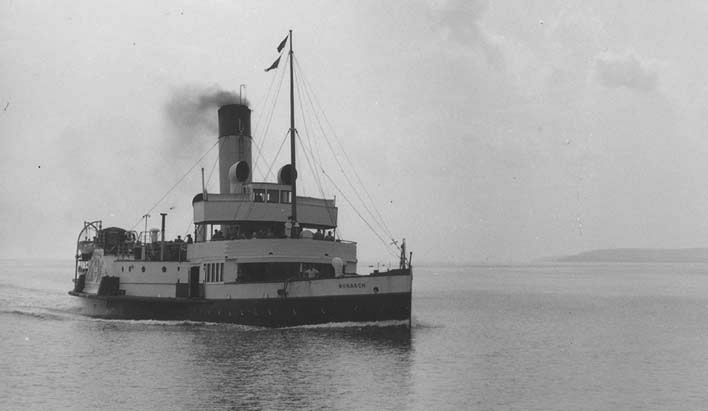
Monarch started the 1957 Bournemouth season on her own in late May covering both the Swanage service and Isle of Wight sailings on different days and was joined by Embassy from the beginning of July.
After that, essentially the Monarch ran the Swanage service with departures from Bournemouth at 10.30am, 12.30pm (Tuesdays, Wednesdays & Thursdays), 2.15pm, 4pm, 6pm (Mondays, Fridays & Saturdays) or 6.30pm (Tuesdays, Wednesdays and Thursdays) and from Swanage at 9am (Tuesdays, Wednesdays and Thursdays), 11.30am, 1.15pm (Tuesdays, Wednesdays and Thursdays), 3.15pm and 5pm.
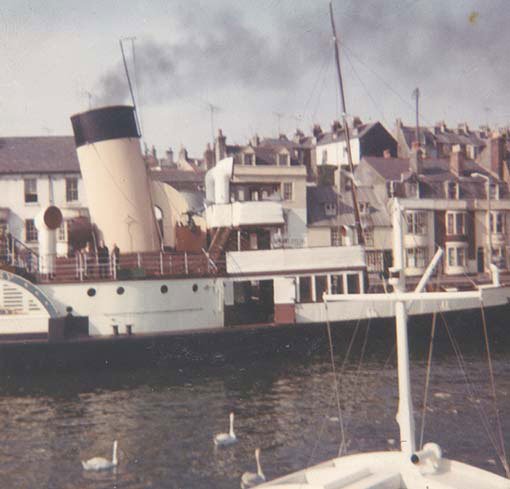
Embassy operated the Isle of Wight service which usually comprised either two round trips from Bournemouth to Totland Bay or Yarmouth departing at 10am and 2.30pm (3.30pm on many Thursdays) or, a couple of days a week, often Tuesdays and Wednesdays, carried on elsewhere.
For example, on Tuesday 13th August 1957 Embassy’s departure from Bournemouth at 10am offered a day trip to Totland Bay, with optional motor coach tour round the island, a Special Cruise to Southampton Docks to view the Queen Mary, or a Grand Cruise through the Solent to Cowes (two and a half hours ashore) all getting back to Bournemouth at 6.30pm
The following day the 10am sailing to Totland Bay was extended into a ‘A Grand 85 miles cruise of picturesque scenery round the Isle of Wight calling at Shanklin’.
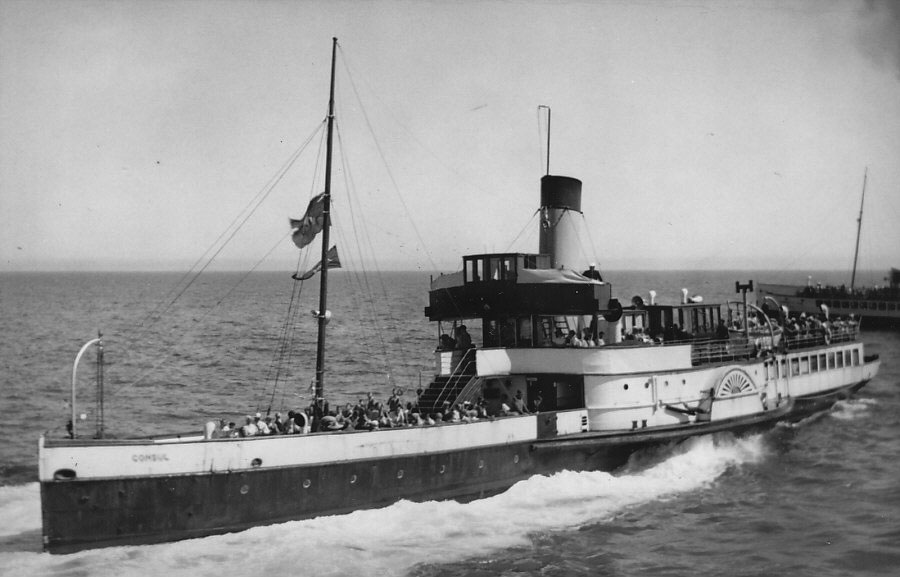
Usually on Tuedays and Thursdays Consul came up from Weymouth to Swanage and Bournemouth offering a 2.30pm departure from Bournemouth for a ‘Cruise Towards the Needles Lighthouse’, before setting off back for Weymouth at 4.15pm.
On some Fridays Consul ran from Weymouth to Swanage and Totland Bay thereby offering those in Swanage a direct crossing to the Isle of Wight without having to go via Bournemouth.
A couple of evenings each week either Monarch or Embassy took a 7.45pm ‘Evening Cruise Towards the Needles Lighthouse with the Evening Serenaders’ back 9.30pm and once a week an 8pm ‘Special Evening Cruise – Dancing on Deck to Charlie Richards’ Band with Guest Artistes Specially Engaged’ back 10.30pm.
Monarch and Embassy over-nighted alongside at Poole Quay so had a one hour or a one and three quarter hour advertised positioning run at the start and finish of each day depending on whether they sailed directly between Bournemouth and Poole or via Swanage. They were long steaming days from 8am or 9am through to 7.30pm or 11.30pm, depending on the schedule, with the ships and crews being rostered to have only one day off a fortnight, Saturdays, which, as change-over day, required no Isle of Wight service and only one vessel on the Swanage service.
However the crew did have Sunday mornings off with sailings not commencing until the afternoons thereby allowing those of a Godly disposition to attend church in the morning and those of a less Godly disposition to have a lie in. Looking back from today’s perspective with shops and just about everything else open on Sundays like every other day, it is easy to forget that in the 1950s Sundays were still regarded as special days of rest and church attendance was significantly higher than it has become in recent years.
With one ship less at Bournemouth in 1957 some of the cruises previously run by Embassy were dropped including the four hour ‘Grand Channel Cruise To Lulworth Cove’. On these Embassy had sometimes ventured inside the cove to give a better view but she was without the necessary door in the bulwark in the bow for the landing gear so I don’t believe that she ever actually put passengers ashore there.
With generally only two scheduled each week, the longer day trips were also in decline by 1957. For example and by contrast, in the week commencing 24th August 1953 Embassy had run to Weymouth and Portland on the Monday, round the Isle of Wight on the Tuesday, to Southampton Docks to see the Queen Mary on the Wednesday and to see the United States on the Thursday and on the Friday offered a landing trip to Lulworth Cove with her passengers transferring to Consul at Swanage and her passengers transferring to Embassy to proceed on to Totland Bay.
In 1957, Consul was scheduled to make her last call at Bournemouth on Tuesday 10th September with Monarch finishing on Saturday 14th September and Embassy time-tabled to make her last trip to Totland Bay on Thursday September 26th before proceeding to join her consorts laid up for the winter in Weymouth.
That gave Monarch a season of about one hundred operating days and Embassy one of little more than seventy.
The financial results from the season were an improvement on the previous year’s loss with an overall profit being declared of £9,428 19s 8d which is about £216K in today’s money with the Director’s report stating that ‘it is particularly pleasing to record that in spite of bad weather the steamer services contributed to the trading profit. This was primarily due to the decision to operate two ships only at Bournemouth and to restrict the services to the peak holiday months.’
In this you can’t fault the logic of Cosens. Of course if there is business to be had the assets of a company should be fully utilised to take advantage of it running as much as possible but there is no benefit in steaming expensive boats around doing interesting and exciting things if they are loosing money hand over fist in the doing of it. It is better for a boat to be tied up than doing that and a surplus of £100 on a turnover of £1K is a better result that than a loss of £1K on a turnover of £10K.
A trading profit is of course always a good thing but the scale here with Cosens in 1957 was not great with the £216k needing to be set against the loss of £94k the previous year. Remember also that this is the profit from a three ship service, a works department undertaking general ship repairs and the operation of a cold store. There was not a lot of fat in that profit and that is for sure particularly in an uncertain world where regulatory changes plus more onerous demands from the licensing authority can gobble up cash on a bewildering scale. ‘Let’s have all the cement wash out of the bilge and the boiler lifted for inspection next year’ are words from a surveyor which peeled the death knell for any operator who just could not afford to do it and by the mid 1960s that was all of them.
Kingswear Castle returned to service in 2023 after the first part of a major rebuild which is designed to set her up for the next 25 years running on the River Dart. The Paddle Steamer Kingswear Castle Trust is now fund raising for the second phase of the rebuild. You can read more about the rebuilds and how you can help if you can here.
John Megoran

